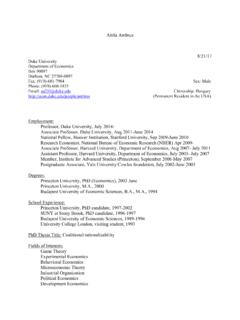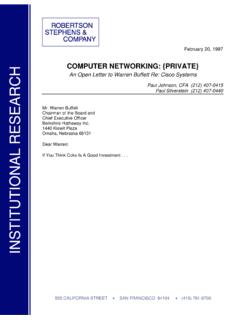Transcription of THE EVOLUTION OF THE IDEA OF “VALUE INVESTING”: FROM ...
1 THE EVOLUTION OF THE IDEA OF VALUE INVESTING : FROM BENJAMIN GRAHAM TO warren buffett Robert F. Bierig1 Duke University Durham, North Carolina April 2000 1 Robert F. Bierig graduated summa cum laude and Phi Beta Kappa in 2000 from Duke University, where he studied economics and art history. During summer 1999, he worked for the investment firm of Ruane, Cunniff & Co. in New York City. He is currently employed as an investment banking analyst at Morgan Stanley Dean Witter in New York. Mr. Bierig grew up in Highland Park, Illinois. 2 Acknowledgments From his freshman seminar on the life of John Maynard Keynes and in his many subsequent courses over the following four years, Professor E.
2 Roy Weintraub instilled in me and many others an interest in the substance and history of economics. That interest led to my research on the EVOLUTION of the idea of value investing that is reflected in this paper. I would like to thank Professor Weintraub for his criticism and his insights that helped shape both this thesis and my development as a student of economics. 3A Note on Sources This paper draws on the writings, speeches, and lectures of Benjamin Graham, warren buffett , their associates, and fellow practitioners; many biographies, interviews, and business histories; and relevant articles in newspapers, magazines, and professional journals. On the life and career of Benjamin Graham, the most balanced and thoroughly researched source is without question Janet Lowe s Benjamin Graham on Value Investing.
3 Lowe portrays Graham and his ideas through the eyes of several of his most devoted students, and her effort stands as the definitive biography on Graham. Benjamin Graham: The Father of Financial Analysis by Irving Kahn and Robert D. Milne also provides useful information on Graham s personal and professional experiences, although it tends to take a somewhat overly-reverential perspective. Readers wanting to learn more about Graham s personality and outside interests as well as about the times in which he lived will find Benjamin Graham: The Memoirs of the Dean of Wall Street (New York: McGraw-Hill, 1996), a memoir that looks back on Graham s early, formative decades, both fascinating and genuinely insightful.
4 Roger Lowenstein s biography of warren buffett also contains an excellent biographical section on Graham and is probably the best source dealing with Graham s direct influence on buffett . John Train s The Money Masters presents a solid overview of Graham s investment philosophy that can serve as a useful introduction to the field. The definitive biography on warren buffett must be Roger Lowenstein s buffett : The Making of an American Capitalist. Lowenstein, a veteran reporter at the Wall Street Journal and a longtime shareholder of Berkshire Hathaway, gained unprecedented and unparalleled access to buffett s family members, friends, business associates, and others and he has written a biography that succeeds more than any other in capturing the essence of buffett , both as a businessman and as a human being.
5 Robert Hagstrom s The warren buffett Way helps readers understand buffett s basic methodology in analyzing prospective investments, although it does not contribute much new material. However, The warren buffett Portfolio (Hagstrom s second book), sets buffett s approach in a broader context and persuasively elucidates the power of buffett s philosophy. In addition, readers searching for any and all pieces of information (no mater how trivial!) on buffett will enjoy Andrew Kilpatrick s Of Permanent Value: The Story of 4 warren buffett (Birmingham, AL: AKPE, 1998), which functions as a veritable encyclopedia of buffett arcana. Forbes and Fortune have done a remarkable job of covering buffett s career over the years.
6 Carol Loomis, a senior editor at the latter magazine and a close friend of buffett s, consistently writes the most in-depth and reliable articles in this area. buffett himself has written numerous articles in various publications over the years, but by far the most important source regarding buffett s thinking is his letters to shareholders in the Berkshire Hathaway Annual Prior to buffett s involvement in Berkshire, the best source regarding his thinking is his letters to partners in buffett Partnership, Ltd., beginning in the buffett has also given several talks to students at colleges and high schools across the country, but his most significant speech is The Superinvestors of Graham-and-Doddsville delivered to students at Columbia Business School in 1984.
7 Finally, Outstanding Investor Digest provides extremely long features and interviews with the nation s most successful investors and money managers. Edited by Henry Emerson, OID is the single best source of timely information about the opinions and activities of value investors, especially warren buffett and his closest circle of like-minded investors. In this paper, we rely heavily on OID for many otherwise impossible-to-access primary sources ( , speeches and lectures) by buffett , Munger, and others as well as relevant secondary sources ( , notes from past Berkshire annual meetings and various investment conferences). 1. Introduction Before the stock market crash of 1929, portfolio investment was a disordered and muddled activity.
8 Benjamin Graham and David L. Dodd s Security Analysis, first published in 1934, brought structure and logic to the field, creating an intellectual framework for sound investment. In an area where much looks foolish shortly after publication, Graham s principles have proved reliable for over sixty-five years. Moreover, as warren buffett wrote in a 2 These letters are of particular interest from 1977 onward. Note: they can be accessed via the Berkshire Hathaway website ( ) free of charge. 3 Although these letters are not available to the public, they are cited heavily by buffett s biographers and can very likely be obtained (as I have done) by contacting former partners.
9 5remembrance about Graham in the Financial Analysts Journal, their value has often been enhanced and better understood in the wake of financial storms that demolished flimsier intellectual structures. 4 Graham mostly operated in a business environment conditioned by the extreme economic collapse of the 1930s. Indeed, the majority of investors remained shell-shocked for many years thereafter. As a result, Graham and his disciples could readily find extraordinary bargains in the public securities markets. However, in investing, like in life, one must adapt to the conditions at hand. Investors in the United States eventually gained insight from the recognition that stocks had been chronically mispriced on the low side.
10 Accordingly, investors bid stock prices higher and higher, and, by and large, the most obvious bargains of the type Graham had always searched for vanished. Thus, in order to remain successful, the Ben Graham disciples had to change their definition of a bargain in various ways. Graham s most famous pupil, warren buffett of Omaha, Nebraska, is generally credited with refining and enlarging his mentor s principles. Both because of the enormous size of buffett s chief investment vehicle, Berkshire Hathaway, and because he finds businesses more interesting than did Graham, buffett tries to find businesses whose cash flows he expects to grow substantially in the future. This paper will trace the EVOLUTION of Graham s and buffett s ideas in response to changes in both economic conditions and their own experiences.



















